Fishery vessels play a critical role in modern fishing practices, serving as the backbone of the global fishing industry.
They encompass a wide range of boats designed for different functions, from catching fish to transporting them or conducting scientific research. These vessels are vital in ensuring the sustainability and growth of the global fish market.
What Defines Fishery Vessels?
The term "fishery vessels" refers to all boats used for fishing activities. While the narrower definition includes traditional fishing boats, the broader term encompasses any vessel involved in the fishing industry, whether for catching fish, processing them, or supporting the operations that make fishing possible. The vessels can vary significantly in size, purpose, and technology, depending on the type of fishing they support.
Types of Fishery Vessels
There are several categories of fishery vessels, each serving a unique role in the fishing process. These include fishing boats, aquaculture vessels, and various auxiliary vessels that support the industry. The classification of fishery vessels is based on factors such as size, function, and the waters in which they operate.
Fishing Vessels: Catching the Catch
Fishing vessels, which are responsible for capturing fish, come in different types based on the fishing methods used. Some common types include Trawlers, Purse Seiners, Drifters, Longline Fishing Boats, and Pole Fishing Boats. Each of these vessels is specialized for particular fishing techniques, from bottom trawling to long-line fishing.
Trawlers are often divided into single or double trawls, and they are designed for deep-sea and near-shore fishing.
Purse Seiners are large vessels that use a surrounding net to capture schools of fish. They can operate alone or in pairs.
Drifters are typically used for drifting nets to capture fish, particularly those moving with ocean currents.
Longline Fishing Boats utilize long lines equipped with multiple baited hooks to catch fish across large distances.
Pole Fishing Boats are typically used for catching fish via a fishing pole, often in shallow waters.
Auxiliary Fishery Vessels
In addition to the primary fishing vessels, there are many auxiliary vessels that serve vital support roles in the fishing industry. These vessels include:
Transport vessels that move harvested fish to processing facilities or markets.
Research and survey boats used to gather data on fish populations, water conditions, and ecosystem health.
Training boats that help train new fishermen in the skills needed for modern fishing operations.
Leisure fishing boats that cater to recreational fishing activities, allowing enthusiasts to enjoy the sport while contributing to local economies.
Classification of Fishery Vessels Based on Material
Fishery vessels can also be classified based on the materials used in their construction. The most common materials include:
Steel for durability and strength, especially for large vessels.
Wood for smaller, traditional boats, often used in local, coastal fishing operations.
Fiberglass for lightweight, cost-effective vessels that can handle a variety of fishing conditions.
Mixed materials such as steel-wood hybrids for boats that need both strength and flexibility.
Each material offers different advantages in terms of durability, maintenance, and cost, and the choice often depends on the specific needs of the fishing operation.
Size and Power: How Vessels Are Classified
Fishery vessels can also be classified by size and engine power. In general, fishing boats are divided into three categories based on these factors:
Small vessels (less than 12 meters in length) are typically used for inshore fishing and are often operated by small, local fleets.
Medium-sized vessels (between 12 to 24 meters) are more versatile and can handle both inshore and some offshore operations.
Large vessels (more than 24 meters) are capable of operating in deep-sea environments and typically have higher engine power to support extended fishing trips.
For classification purposes, vessels with a main engine power of less than 44.1 kW are considered small, while those with higher power fall into the medium or large categories.
Supporting Roles of Fishery Vessels
Fishery vessels not only serve the primary function of catching fish but also support the industry in various other ways. These include:
Regulatory and enforcement vessels, which ensure that fishing activities comply with local laws and sustainability standards.
Supply vessels, which provide fuel, food, and other essential supplies to fishing boats operating at sea.
Scientific research vessels, which are used by marine biologists to study fish populations, oceanography, and other aspects of the marine environment.
These supporting vessels help ensure the continued success of the fishing industry while promoting sustainability and conservation efforts.
The Importance of Fishery Vessels in Global Fishing
Fishery vessels are essential to the success of the global fishing industry. From traditional fishing boats to high-tech research vessels, these ships ensure that fish are caught sustainably, processed, and transported to markets worldwide. Whether you're interested in commercial fishing, marine research, or simply curious about the maritime world, understanding these vessels will give you a deeper appreciation for the complexity of global fisheries.
Feel free to share your thoughts, Lykkers! Would you like to dive deeper into any specific type of vessel or its function? Let’s chat!


